Text
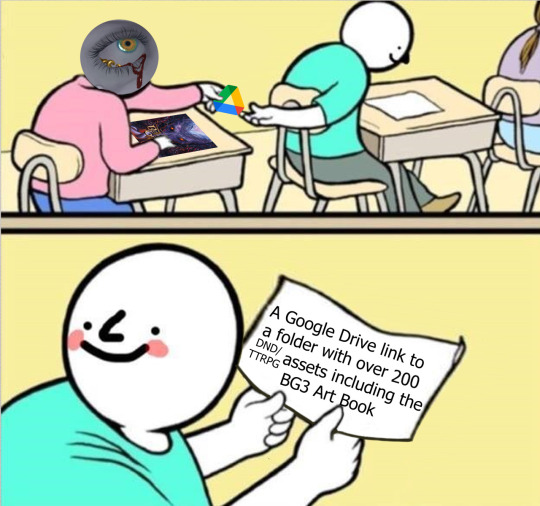
I might've added the BG3 Art Book to my dnd assets stash
It' 100% does not have things like the 5e players' handbook + 5e’s character sheet, several gm guides, critical role's explorer's guide to wildmount, baldur's gate and waterdeep city encounters, 101 potions and their effects, volo's guide to monsters, both of xanathar's guides, a bunch of other encounters, one shots, and class builds
In no way are there any pdf’s relating to any wizard who may or may not be residing on any coast
(Edit that I’ve moved the folder to the new link above! So if you catch a different version of this post that link won’t work anymore!)
65K notes
·
View notes
Photo
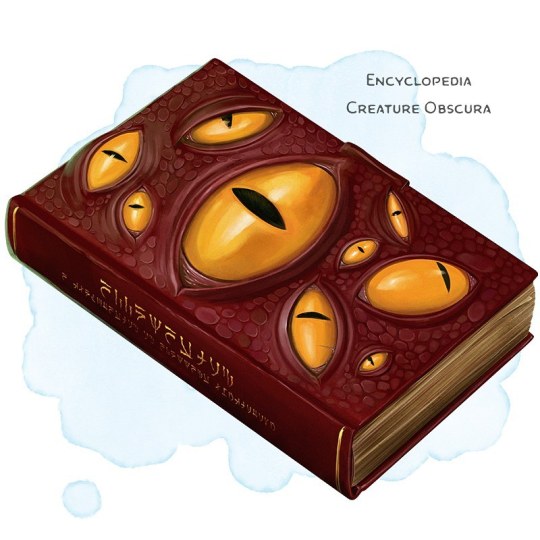
💎 𝗡𝗲𝘄 𝗶𝘁𝗲𝗺!
Encyclopedia Creature Obscura
Wondrous item, rare
___
There are fourteen unique entries in this classic, hard-to-find series of encyclopedic tomes, which were originally written by renowned hunters and archdruids. When found, roll a d20 or choose from the table below to determine which encyclopedic volume it is.
If you have at least 5 levels in the ranger class and spend 48 hours over a period of 6 days or fewer studying the book’s contents and practicing its guidelines, you gain the favored enemy and language (or similar effect) associated with your volume of the encyclopedia. If you have 5 or more levels in the druid class and spend that same time reading it, you can use an action to expend 2 uses of your Wild Shape to transform into the volume’s associated Wild Shape option or cast the listed spell. A benefit gained from the book is permanent.
| 1 | Aberration: A Speculation on Aberrant Physiology | Aberrations; Deep Speech | Gibbering Mouther |
| 2 | Beast: Wild Beasts and Their Domestication | Beasts; beasts can understand the meaning of your words, though you have no special ability to understand them in return | Giant Scorpion |
| 3 | Celestial: The Divinity of Celestials, a Testament | Celestials; Celestial | Pegasus |
| 4 | Constructs: The Inner Workings of Automatons | Constructs; your choice of language | Rug of Smothering |
| 5 | Dragon: The Draconomicon | Dragons; Draconic | Gold Dragon Wyrmling |
| 6 | Elemental: Fire and Water, a Primordial Project | Elementals; Primordial | Gargoyle |
| 7 | Fey: An Interpretation of Fey Minds | Fey; Sylvan | Dryad |
| 8 | Fiend: A Transcript of Fiendish Habits | Fiends; Abyssal or Infernal | Hell Hound |
| 9 | Giant: A Documentation of Giant Culture | Giants; Giant | Ogre |
| 10 | Humanoid: A Study of Humanoid Behavior | Humanoids (any two races); your choice of language | You cast the “alter self” spell (no concentration required) |
… Continued in the comment below!
___
✨ Patrons get huge perks! Access this and hundreds of other item cards, art files, and compendium entries when you support The Griffon’s Saddlebag on Patreon for less than $10 a month!
278 notes
·
View notes
Text
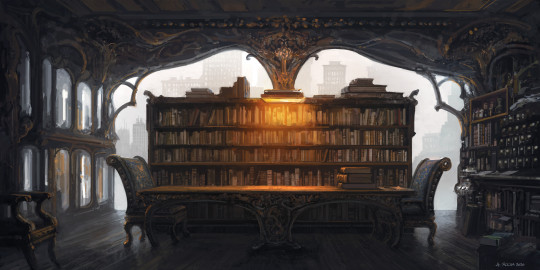
Homebrew Mechanic: Meaningful Research
Being careful about when you deliver information to your party is one of the most difficult challenges a dungeonmaster may face, a balancing act that we constantly have to tweak as it affects the pacing of our campaigns.
That said, unlike a novel or movie or videogame where the writers can carefully mete out exposition at just the right time, we dungeonmasters have to deal with the fact that at any time (though usually not without prompting) our players are going to want answers about what's ACTUALLY going on, and they're going to take steps to find out.
To that end I'm going to offer up a few solutions to a problem I've seen pop up time and time again, where the heroes have gone to all the trouble to get themselves into a great repository of knowledge and end up rolling what seems like endless knowledge checks to find out what they probably already know. This has been largely inspired by my own experience but may have been influenced by watching what felt like several episodes worth of the critical role gang hitting the books and getting nothing in return.
I've got a whole write up on loredumps, and the best way to dripfeed information to the party, but this post is specifically for the point where a party has gained access to a supposed repository of lore and are then left twiddling their thumbs while the dm decides how much of the metaplot they're going to parcel out.
When the party gets to the library you need to ask yourself: Is the information there to be found?
No, I don't want them to know yet: Welcome them into the library and then save everyone some time by saying that after a few days of searching it’s become obvious the answers they seek aren’t here. Most vitally, you then either need to give them a new lead on where the information might be found, or present the development of another plot thread (new or old) so they can jump on something else without losing momentum.
No, I want them to have to work for it: your players have suddenly given you a free “insert plothook here” opportunity. Send them in whichever direction you like, so long as they have to overcome great challenge to get there. This is technically just kicking the can down the road, but you can use that time to have important plot/character beats happen.
Yes, but I don’t want to give away the whole picture just yet: The great thing about libraries is that they’re full of books, which are written by people, who are famously bad at keeping their facts straight. Today we live in a world of objective or at least peer reviewed information but the facts in any texts your party are going to stumble across are going to be distorted by bias. This gives you the chance to give them the awnsers they want mixed in with a bunch of red herrings and misdirections. ( See the section below for ideas)
Yes, they just need to dig for it: This is the option to pick if you're willing to give your party information upfront while at the same time making it SEEM like they're overcoming the odds . Consider having an encounter, or using my minigame system to represent their efforts at looking for needles in the lithographic haystack. Failure at this system results in one of the previous two options ( mixed information, or the need to go elsewhere), where as success gets them the info dump they so clearly crave.
The Art of obscuring knowledge AKA Plato’s allegory of the cave, but in reverse
One of the handiest tools in learning to deliver the right information at the right time is a sort of “slow release exposition” where you wrap a fragment lore the party vitally needs to know in a coating of irrelevant information, which forces them to conjecture on possibilities and draw their own conclusions. Once they have two or more pieces on the same subject they can begin to compare and contrast, forming an understanding that is merely the shadow of the truth but strong enough to operate off of.
As someone who majored in history let me share some of my favourite ways I’ve had to dig for information, in the hopes that you’ll be able to use it to function your players.
A highly personal record in the relevant information is interpreted through a personal lens to the point where they can only see the information in question
Important information cameos in the background of an unrelated historical account
The information can only be inferred from dry as hell accounts or census information. Cross reference with accounts of major historical events to get a better picture, but everything we need to know has been flattened into datapoints useful to the bureaucracy and needs to be re-extrapolated.
The original work was lost, and we only have this work alluding to it. Bonus points if the existent work is notably parodying the original, or is an attempt to discredit it.
Part of a larger chain of correspondence, referring to something the writers both experienced first hand and so had no reason to describe in detail.
The storage medium (scroll, tablet, arcane data crystal) is damaged in some way, leading to only bits of information being known.
Original witnesses Didn’t have the words to describe the thing or events in question and so used references from their own environment and culture. Alternatively, they had specific words but those have been bastardized by rough translations.
Tremendously based towards a historical figure/ideology/religion to the point that all facts in the piece are questionable. Bonus points if its part of a treatise on an observably untrue fact IE the flatness of earth
452 notes
·
View notes
Text


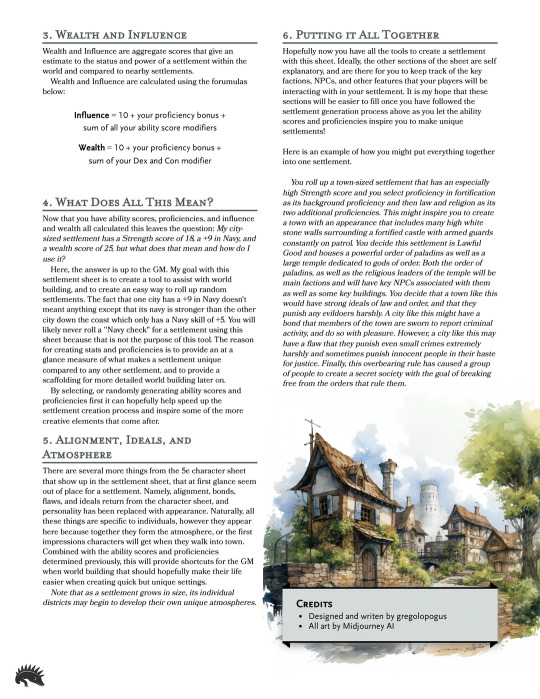

The settlement character sheet by gregolopogus on reddit
492 notes
·
View notes
Text

My clever words could never paint
The picture that your name creatеs
The gory glory, body count
The way you spin the world around
Thе color of the blood upon your blade
You put other men to shame
I couldn't possibly explain
I'm at a loss
- Song of Praise, Shayfer James & Kate Douglas
17 notes
·
View notes
Text
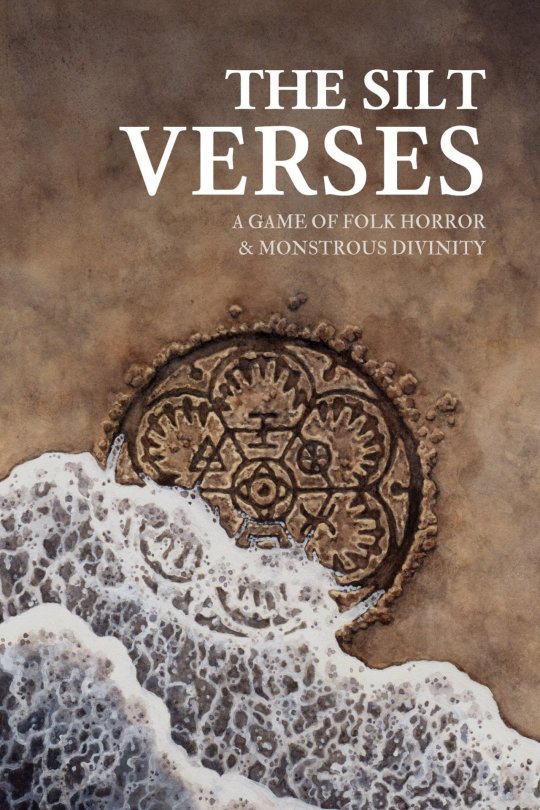
The Silt Verses RPG has just launched from the acclaimed designers of Brindlewood Bay and The Between!
Investigate stray angels, strange haunts, and murderous cults in a world of gods and sacrifice as a disciple of the Saint Electric, Trawler-man, Watcher in the Wings, Cairn Maiden, Pox Martyr, or the Waxen Scrivener.
Delve into backwoods towns, floating markets where sacred relics are bought and sold, bustling clinics where medical 'miracles' come at a hideous cost - and even a towering skyscraper of conjoined steel, glass, and flesh.
You can purchase a copy over on DriveThruRPG, or at the Silt Verses or The Gauntlet Patreon, netting you the rulebook, 8 Assignments, 6 Faith Sheets, 8 Journey Sheets, and more.
This game really is a labour of love from a small team of innovative indie RPG creators, and already a genuine work of art (so we'd be incredibly grateful for your help in playing, giving feedback, and spreading the word far and wide) - we think it's an absolutely fantastic achievement, and we know The Gauntlet are only going to keep building and improving on the game from here.
You can find out more by joining The Gauntlet Discord.
558 notes
·
View notes
Text
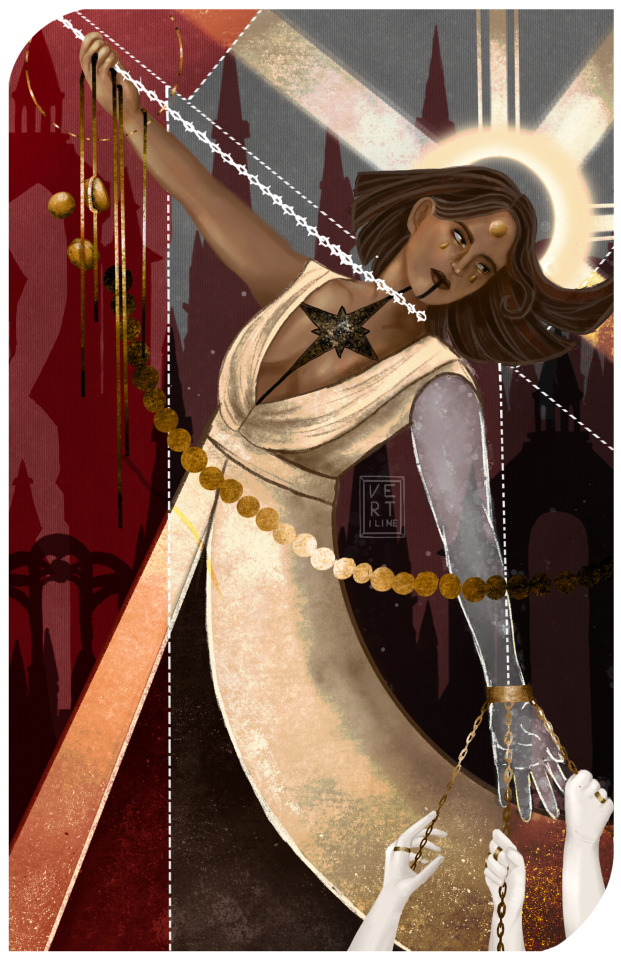



Been working on some tarot card designs of DnD characters for me and my friends. Considering opening up for commissions in this style.
29 notes
·
View notes
Text
Resources For Fantasy & Mythology Writers

Designing A World
City and Town Name Generator
How To Create a Believable World
Fantasy Religion Design Guide
Fantasy Map-maker
The Language Construction Kit
Fantasy Name Generator
The Pagan Name Generator
Writing Fantasy: Tools & Techniques
Fractal World Generator
Creating a Magic System
The Middle Ages
A Large List Of Articles On The Middle Ages
Middle Ages Weapons
Medieval Clothing
Medieval Clothing Pages
Medieval Name Archive
The Domesday Book
European Nobility Titles
Mythology
General Folklore
Various Folktales
Heroes
Weather Folklore
Trees in Mythology
Animals in Mythology
Birds in Mythology
Flowers in Mythology
Fruit in Mythology
Plants in Mythology
Folktales from Around the World
Egyptian Mythology
African Mythology
More African Mythology
Egyptian Gods and Goddesses
The Gods of Africa
Even More African Mythology
West African Mythology
All About African Mythology
African Mythical Creatures
Gods and Goddesses
Aztec Mythology
Haitian Mythology
Inca Mythology
Maya Mythology
Native American Mythology
More Inca Mythology
More Native American Mythology
South American Mythical Creatures
North American Mythical Creatures
Aztec Gods and Goddesses
Chinese Mythology
Hindu Mythology
Japanese Mythology
Korean Mythology
More Japanese Mythology
Chinese and Japanese Mythical Creatures
Indian Mythical Creatures
Chinese Gods and Goddesses
Hindu Gods and Goddesses
Korean Gods and Goddesses
Basque Mythology
Celtic Mythology
Etruscan Mythology
Greek Mythology
Latvian Mythology
Norse Mythology
Roman Mythology
Arthurian Legends
Bestiary
Celtic Gods and Goddesses
Gods and Goddesses of the Celtic Lands
Finnish Mythology
Celtic Mythical Creatures
Gods and Goddesses
Islamic Mythology
Judaic Mythology
Mesopotamian Mythology
Persian Mythology
Middle Eastern Mythical Creatures
Aboriginal Mythology
Polynesian Mythology
More Polynesian Mythology
Mythology of the Polynesian Islands
Melanesian Mythology
Massive Polynesian Mythology Post
Maori Mythical Creatures
Hawaiian Gods and Goddesses
Hawaiian Goddesses
Gods and Goddesses
List of Gods
Encyclopedia Mythica
Mythical Creatures & Beasts
Questions To Ask When Worldbuilding
The World
Physical and Historical Features
Magic and Magicians
Peoples and Customs
Social Organization
Commerce, Trade, and Public Life
Daily Life
Basics
Alternate Earth
Not Earth at All
Climate and Geography
Natural Resources
World History
Specific Country(s) History
Rules of Magic
Wizards
Magic and Technology
Miscellaneous Magic Questions
Customs
Eating
Greeting and Meeting
Gestures
Visits
Language
Ethics and Values
Religion and the Gods
Population
Government
Politics
Crime and the Legal System
Foreign Relations
Waging War
Weapons
Business and Industry
Transportation and Communication
Science and Technology
Medicine
Arts and Entertainment
Architecture
Urban Factors
Rural Factors
Fashion and Dress
Manners
Diet
Education
Calendar
Magic
The Hypertext List of Spells
Gemstone Properties
Gemstone Meanings
Crystal Healing
Fairy & Other Spirits
Elven Phrases
54K notes
·
View notes
Photo
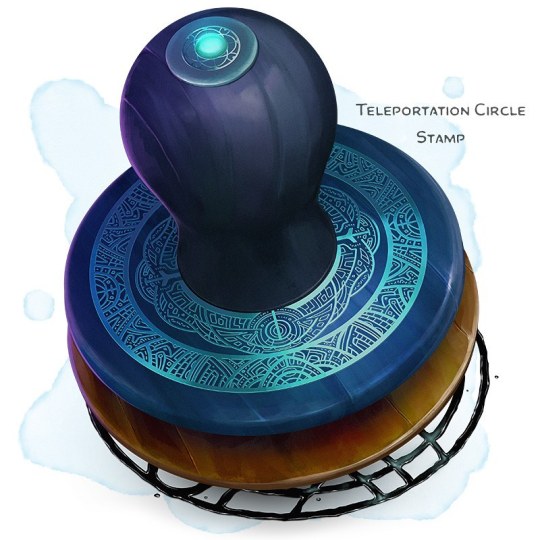
💎 𝗡𝗲𝘄 𝗶𝘁𝗲𝗺!
Teleportation Circle Stamp
Wondrous item, rare
___
This handheld stamp is covered in arcane glyphs. When found, there is a 20 percent chance that it has a sigil sequence for a permanent teleportation circle carved into its wooden base, which has a diameter of 4 inches.
You can carve a miniaturized sigil sequence that you know into the base of the stamp, provided it doesn’t have one already. If it does, you can sand it flat and carve a new one instead. Either option takes 1 hour of careful work using a set of woodcarver’s tools. If you’re proficient with woodcarver’s tools, it takes 10 minutes of work instead.
While holding the carved stamp, you can use an action to apply a wash of fine inks worth no less than 10 gp onto its carved base. You can then use an action on a following turn within 1 minute to press the inked stamp onto a flat surface within your reach, creating a special “teleportation circle" at that point that’s 4 inches across. The circle remains until the end of your next turn, at which point it flashes with arcane power and disappears.
Any object that’s fully within the circle’s area is magically teleported to the linked teleportation circle when it disappears. Creatures can’t be teleported using this special circle, and any item that creates an extradimensional space, such as a "portable hole,” fails to teleport through the circle when it disappears.
___
✨ Patrons get huge perks! Access this and hundreds of other item cards, art files, and compendium entries when you support The Griffon’s Saddlebag on Patreon for less than $10 a month!
624 notes
·
View notes
Text
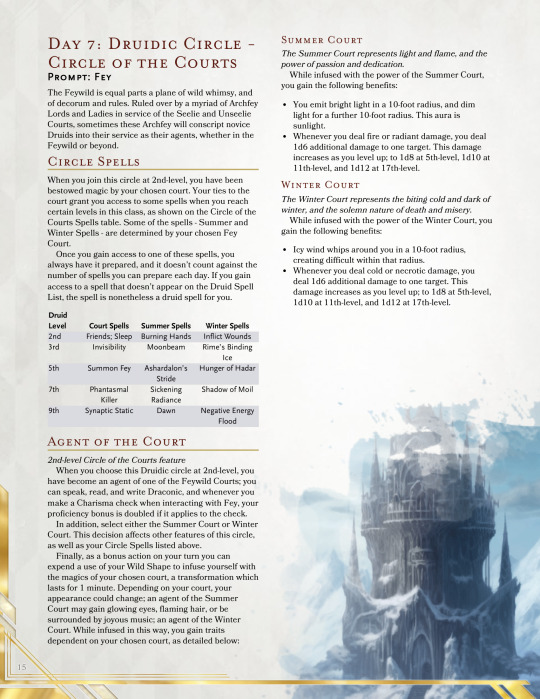

Subclasseptember 2023, Day 7 - Circle of the Courts
I do love the Feywild, the whole contrast of Summer and Winter, the weird social chess-playing, its a lot of fun.
This one is...a tricky one. An attempt at a sort-of social Druid and a specialised blaster, and I'm not sure it does incredibly at both.
118 notes
·
View notes
Text
I wish more people used Magic the Gathering's Color Pie instead of D&D's alignment all of the time.
Like, saying a character embodies the selfishness and impulsivenes of Red Black offers more depth than Chaotic Evil
12K notes
·
View notes
Text

Subclasseptember Day 16: Weather
The Circle of Ruins - Homebrew Druid Subclass
Given their association with structures like Stonehenge, I'm surprised that this isn't already a thing.
Explicitly designed to be a tanky caster (unlike some subclasses *cough bladesinger cough*), with ways to help maintain concentration and further play into the delayed value that the Druid class already encourages. You broke my concentration on Call Lightning? Good thing I had a Moonbeam cooking that entire time. It also plays into some novel weaknesses, though - you're durable, but mobility is not exactly your strong suit. Endure as the ruins do.
239 notes
·
View notes
Text
One of the worst flaws of d20-era (a.k.a. post-3e) D&D is that despite its attempts to codify mechanics for SO MUCH shit that would just be adjudicated on the fly by the GM in previous editions, they lack codified mechanics for enemy morale and I think that’s a big reason why combat encounters tend to become so drawn-out and tedious.
Like, my first edition was 3.5e and I remember the Dungeon Mater’s book had this little section about how most creatures probably wouldn’t fight to the death unless they’re like mindless undead, but it lacked any sort of advice on WHEN it might be appropriate to make creatures surrender, flee, negotiate, etc. I think 5e has a weaksauce attempt at a morale roll using a wisdom saving throw, but it’s presented as an optional rule and most people ignore those. (Also like. Even when people do decide to use it. Using a wisdom saving throw means that creatures with higher wisdom are more likely to stay and fight to the death, which is just stupid)
All pre-3e editions (OD&D, B/X, BECMI, AD&D, etc) had this really simple but cool morale system that’s still used by A LOT of OSR games, where every creature’s stat block had a morale value between 2 and 12, measuring their courage and loyalty. In combat, the GM would test morale for every enemy:
The first time they see a creature on their side die
When 50% of their group has been defeated
(This isn’t in the original D&D morale rules but a lot of OSR games add it too) When their leader is defeated.
The GM would roll 2d6 for every enemy, and if the result was greater than their morale, they’d attempt to flee or surrender. It’s simple, it’s elegant, it takes the guesswork out of when it’s appropriate for monsters to flee, and it provides an easy way to characterize certain enemies as more or less likely to stay and fight to the death.
8K notes
·
View notes
Text
I think a lot of the advice about running tabletop RPGs that you get on this site tends to forget that groups typically have more than one player. Like, yes, facilitating player agency is any competent GM's goal, but y'all, the reason the player who wants to immediately stab every named NPC in the face is reviled isn't because control-freak GMs don't like having their plans ruined. It's because if you let that player have their way, they're the only one who gets to exercise any agency at all. Either the entire group only does what the maximum-disruption-all-time-time player wants to do, forever, or they kick that player out of the game. Those are the only options – and that player knows it. They're exploiting the group's natural tendency to seek consensus to issue a tacit ultimatum: "either everyone does what I want, or the in-game drama escalates to out-of-game drama". That's why people hate dealing with that player – it's not just a GM thing.
6K notes
·
View notes
Text
Random Worldbuilding Questions
Are there any foods with symbolic meanings that are eaten on special occasions (e.g. katsudon for victory, or new years oranges for luck)? How did the tradition get started?
We all know about weddings and marriage, but are there any ceremonies that symbolically / legally / magically officialize a different type of relationship in your world’s culture? (Adoption, apprenticeship, friendship, etc.)
What’s a rule or social norm that is widely followed in theory, but in practice everyone knows it’s not a big deal and breaks it all the time?
Are there any trades or hobbies whose practitioners are stereotyped as weird or extraordinary? (E.g. the “mad hatter” trope.) Why? How true is this perception?
What are some cliches, tropes, and/or plots that commonly appear in stories written by your world’s inhabitants? What were they inspired by? Why are they popular?
What is a common way to subtly insult someone in your world, without crossing into overt rudeness? Gifting an item with negative connotations? Addressing them more familiarly or formally than normal? Backhanded compliments?
If you pulled a random average Joe off the streets of your world and asked them to draw a house, what would they draw? (Shape, roof style, position and number of windows, etc.)
Is there a place in your world that nobody has ever been to - the bottom of a cave, the moon, another dimension, etc.? How do people know it exists? Why haven’t they gone there? What do they believe it’s like, and how right/wrong are they?
What aesthetics are considered “advanced” or “futuristic” in your world - canvas wings, shiny chrome, smooth plastic? How has this changed over time?
What’s a fun fact about your world that you as the worldbuilder are dying to share, but nobody ever thinks to ask?
3K notes
·
View notes
Text
I think it's actually really important to treat the GM as another player. The GM is there to have fun just as much as the other players.
Of course the GM shouldn't have fun at the expense of the other players. But the converse also applies. If the players make it a point to ruin the GM's plans or not engage with what the GM has brought then that's also a bad group dynamic.
What this also means is that the GM doesn't need to be the only one with access to system mastery. In fact, the best way to avoid GM burnout is by sharing some of the administrative burden. Maybe instead of turning to the GM (who is already having to shuffle between their notes and NPC stats and clocks and dials) for rules question you turn to the Rules Lawyer (who gets a lot of unnecessary flak imo, like why is game mastery something that is actively demonized in the hobby?). If you're playing one of them cool combat minigames with lots of initiatives and statuses and so on to keep track of then maybe elect one of the players who's good with that sort of thing as the Combat Tracker.
But okay I mentioned that it's not the GM's job to have fun at the expense of the players, right? But there's kayfabe. Basically, in some contexts the GM is playing the role of the heel to the players' faces. In certain games the game itself benefits from the GM pretending to be the players' worst enemy even though in reality their job is to make the players look good. Sometimes it does mean pretending to kick the players down so they can rise again.
But that being the case, I think this is something that also should be addressed while setting the expectations for a game. "In this game I won't be pulling punches but it's not because I want to see you fail, but because I want to see you succeed in spite of adversity." Or "I will mostly plan encounters so you can easily breeze through them so you get to shine, but sometimes I will throw a curveball to make victory seem more sweet."
2K notes
·
View notes
Text
Coming up with puzzles for my players has gotta be one of the hardest parts of TTRPG prep. Either the answer will be so glaringly obvious that they'll figure it out immediately or they're going to spend 5 hours talking about it and still get it completely wrong and there's literally no way to know beforehand
1K notes
·
View notes